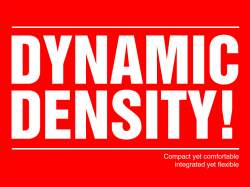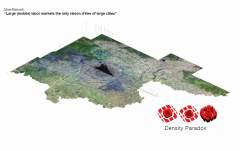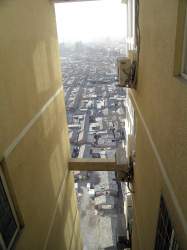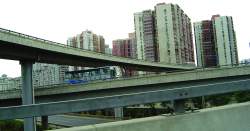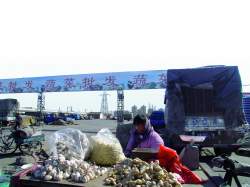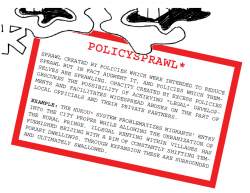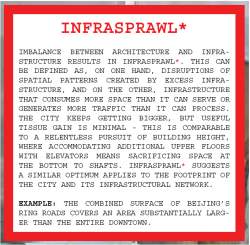Dynamic Density
动态密度
Authors: Neville Mars with research by Saskia Vendel, Elaine Ho and Chang Liu
Video intro TEDx Talk Shanghai "China, on the road to planning 100 new ecocities and satellites will face five fundamental obstacles, that lay bare contradictions right at the heart of the planning discipline.."
VIDEO of Dynamic Density software - part of the BEIJING_REAL-TIME interactive installation
DD-pdf of draft for dummy text + images
DD-pdf of diagrams ONLY
Summary
城市有它自己的逻辑。这意味着我们可以试着去了解它;也意味着我们将无法控制它。在北京,所有谨慎规划的社区和整洁设计的新区加在一起不过是一块更大的饼。当它被摊得越来越大时,它会逐渐异化为一个个被基建设施包围的孤岛。越来越宽的高速公路分裂着城市中心。这不仅制造了交通拥堵,而且降低了行人与公交乘客的可达性。修改北京的法律似乎是解决交通拥挤的唯一方法。但是这可能吗?动态密度这一章探寻的是如何遵循城市本身的意愿,自然地调整城市密度,从而为一个可达性更强的北京创造一个新的中心。CONTINUE HERE: 动态密度

MONSTER METROPOLIS
FORMS WITHIN THE MODERN CITY ARTICULATE A COLLECTIVE INTELLIGENCE. SUCCESSIVE GENERATIONS OF DESIGN SOLUTIONS ARE REMAPPED ON TOP OF ONE ANOTHER WITHIN A CONTINUOUS CHANGE-RESPONSE-ADAPTATION CYCLE. AN EVOLUTIONARY PROCESS ENGENDERS THE NOTION OF AN ORGANIC FORCE. THE CITY BECOMES A “BEAST”: POWERFUL, DISAGGREGATED, INTRACTABLE, PERATING ACCORDING TO A LOGIC OF ITS OWN, AND WITHOUT REFERENCE TO AN OPERATOR. DISTRICTS BECOME ORGANS, HIGHWAYS ARTERIES, URBAN GROWTH THE EXPRESSION OF A DISTINCT AND MONSTROUS WILL. RAPIDLY THE URBANIST FINDS HIMSELF LOCKED IN BONDAGE TO HIS OWN CLICHÉ. EFFORTS TO TAME THE BEAST ARE REMEDIAL; OVERARCHING DESIGN IDEAS SUBJUGATED TO CONDITIONS IMPOSED BY A SOPHISTICATED METROPOLIS.
YET THIS MONSTER ANALOGY IS IN CHINA ESSENTIALLY PASSÉ.SHEER SPEED OF CHANGE HAS EFFECTED A RADICAL BREAK. CITIES ARE EITHER CREATED ANEW OR REBUILT UTTERLY. THERE CAN BE NO EVOLUTION TO FLASH DEVELOPMENT. INSTEAD A CORE PROFITMOTIVE DRIVES MULTIPLE HYBRID VENTURES IN THE PRODUCTION OF ONE-GENERATION-URBANISM. THE MASS INDIVIDUALIZATION OF SOCIETY, IN COMBINATION WITH FRESH OUT-OF-THE-PLASTIC MARKET MECHANICS, STRIPS THE PROCESS OF ANY SUPERIOR ORDERING PRINCIPLE. NEO-CORBUSIAN LANDSCAPES ARE BEING BUILT, BUT ON GROUNDS OF PRAGMATISM NOT IDEALISM. THOUGH DENSE, PROJECTS ARE PERFECTLY UNINTEGRATED, AND THE RATIONAL CITY IS NOT ACHIEVED. STATE CAPITALISM REPLACES SLOW EVOLUTION AS THE PRIMARY MANUFACTURER OF SPATIAL CONFIGURATIONS.
OPERATING UNCHECKED AND AT HYPERSPEED, SUPPLY IS NOT SUBJECT TO MATURE DEMAND. SPATIAL PRODUCTS COMPETE ON THE BASIS OF THE CITY THEY ARE SUPERSEDING (READ DEMOLISHING), NOT ON THE FUTURE CITY THEY ARE COLLECTIVELY CREATING. THE DESIGNER NOW WORKS ON THE LEVEL OF THE HYPER-METICULOUS — MICROPLANNING THE CHROME-FINISH ON THE BELLS OF 1,200 DOORS; THE WINDY ROAD WITHIN THE GATED COMPOUND — WHILE THE SUM OF THESE METICULOUSLY DESIGNED MOMENTS — I.E. THE SYSTEM ITSELF — REMAINS UNDESIGNED. INSTEAD THE CITY IS THE SPATIAL DERIVATIVE OF MARKET-DRIVEN UNINTENTIONAL DEVELOPMENT:MUD*
MUD* IS CAPABLE OF PRODUCING URBAN FORMS FASTER THAN PLANNERS CAN MAP THEM, CITIES ABSORB THEM, OR CONSUMER-INHABITANTS REJECT THEM. MUD* FORMATIONS FOLLOW THE PATH OF LEAST RESISTANCE, PRODUCING AT CHINESE SPEED ESSENTIALLY STATIC REAL ESTATE PROJECTS. A SINGLE ITERATION OF THE BOOM-BUST CYCLE WITHIN CITY-BUILDING WILL HAVE LONG TERM CONSEQUENCES FOR CITY SHAPE AND PERFORMANCE. ULTIMATELY MUD* DEFINES THE FORM. FRAGMENTATION BECOMES THE ULTIMATE THREAT.
THE PURPOSE OF THE CITY IS TO FACILITATE DIRECT CONTACT BETWEEN LARGE NUMBERS OF PEOPLE. IF THE CITY CEASES TO REMAIN LINKED TO ITSELF, IT FAILS. A BODY WHICH OVERSEES THE WELFARE OF THE CITY AS A WHOLE, AND THE PROFITABILITY OF THE CITY AS A WHOLE, WILL NECESSARILY CONSIDER THIS ITS PRIMARY RESPONSIBILITY. THEREFORE ANY OVERARCHING THEORY MUST ADDRESS THE KEY ISSUE OF MAINTAINING FLOWS. THE ORGANIZATION OF DENSITIES THROUGHOUT THE URBAN REGION IS PIVOTAL TO THE EFFICIENCY OF TRIP PROCESSING AND TO THE SAFEGUARDING OF URBAN INTERACTIVITY. AT THE HEART OF COMPREHENSIVE URBAN DESIGN IS A METHODOLOGY FOR LOCATING DENSITIES INTELLIGENTLY.
MODERNISM EXHIBITS A DENSITY FETISH. CULTURAL CONSCIOUSNESS GRANTS IT A METROPOLITAN AURA. THE ICONOGRAPHY OF ADVANCED SOCIETY, LEANING CUPIDINOUSLY TOWARD SCIENCE FICTION, INVARIABLY ASSUMES ULTRA-DENSE STRUCTURES OF CLOSE-KNIT MATHEMATICAL BRILLIANCE, THROUGH WHICH INHABITANTS SURGE AS MULTITUDINOUS AS ELECTRONS. THE AVERAGE RESIDENTIAL CONSUMER HOWEVER, DESPISES DENSITY AND MOVES TO THE SUBURBS. HIGH DENSITY INTERVENTIONS WITHIN EXISTING CITY FABRIC OR SATELLITE SUPPORT TOWNS HAVE PROVED NOTORIOUSLY UNSUCCESSFUL. WHILE BOOSTING THE DENSITY OF PEOPLE PER SQUARE KILOMETER, THEY FREQUENTLY DIMINISH THE DENSITY OF SERVICES PER PERSON, AND VITIATE DIVERSITY. ANALYSIS OF PREVALENT URBAN DISTRIBUTION PATTERNS SUGGESTS A NORMATIVE DENSITY CURVE WITH TWO ESSENTIAL COMPONENTS. FIRST: HIGH PERFORMANCE DENSITY IS COMPOSED OF A CONTEXTUAL MATRIX OF DENSITIES, INCLUDING PEOPLE, PROGRAMMATIC MIX, AND FUNCTIONALITY. SECOND: DENSITY OCCURS WITHIN A TEMPORAL CONTINUUM OF URBAN EXPANSION AND SHIFTING DENSITIES. PLANNING DENSITY CANNOT BE REGARDED IN TERMS OF STATIC ACHIEVEMENTS, BUT INSTEAD MUST INCORPORATE AN UNDERSTANDING OF FLUID INTERACTIONS IN BOTH SPACE AND TIME: DYNAMIC DENSITY*.
DYNAMIC DENSITY* (DD) CONCEIVES OF AN OPTIMAL RELATIONSHIP BETWEEN FOOTPRINT AND POPULATION. URBAN EXPANSION PATTERNS ARE INTELLIGIBLE AND SHOULD CONFORM TO STAGE OF GROWTH MODELING. SCALES RUN FROM VILLAGE TO METROPOLIS, AND FROM RURAL TO URBAN ECONOMY. THE RESULTANT FRA MEWORK PROVIDES OBJECTIVES IN TERMS OF SIZE, SHAPE AND URBAN TEXTURE FOR DEVELOPMENTS ACROSS A WIDE REGIONAL NETWORK OF HIERARCHIES AND INTERDEPENDENCIES. THIS FACILITATES FUTURE PLANNING. IN PLACE OF REMEDIAL MEASURES (E.G. TRANSPORTING DENSITIES OUTWARDS), DD SERVES TO RENDER URBAN FLOWS MORE E HAT ANTICIPATE CONTINUOUS CHANGE EVEN AFTER COMPLETION
DENSITY — PROMOTING COMPACTNESS AS AN UNAMBIGUOUS DIRECTION TO COORDINATE All (CHINA’S) PLANNING EFFORTS.
DD* GOALS ARE FREQUENTLY UNATTAINABLE IN CITIES THAT HAVE FORMED UNDER SYSTEMS OF SLOW EVOLUTION. DEFENSIVE HISTORICAL IMPERATIVES HAVE FOCUSED MORE ON INCULCATING A POLITICIZED SENSE OF PLACE THAN ON INTEGRATING THE INEVITABILITY OF FLUX. THE SITUATION IN CHINA NOW IS DIFFERENT. DENSITY ITSELF IS IRRECUSABLE. POPULATION AND BUILDING DENSITIES ARE AMONG THE HIGHEST IN THE WORLD, AND MUD*- DEFINED INTERACTIONS PRODUCE NATURALLY COMPACT TYPOLOGIES. APPLYING DYNAMIC PLANNING LOGIC TO THE PHENOMENON OF MUD* OFFERS THE OPPORTUNITY TO HARNESS CHINA’S PREDILECTION FOR HIGH-RISE HIGH-SPEED DEVELOPMENT AND SET IT TOWARD THE PRODUCTION OF FUTURE-PROOFED CONFIGURATIONS. IN STARK OPPOSITION TO EVOLUTION’S MULTI-GENERATIONAL URBAN MONSTER, FOR WHOM THEORETICAL APPROACHES TO DENSITY ARE NOT BACKWARDS COMPATIBLE, IT BECOMES CONCEIVABLE TO BUILD CITIES WHICH ARE FORWARDS COMPATIBLE: URBAN STRUCTURES CREATED BY FLASH VENTURES, WHICH THROUGH AN UNDERSTANDING OF DD INCORPORATE WITHIN THEIR FABRIC THE POSSIBILITY FOR FUTURE ADAPTATION. IMMEDIATE INSTANTIATIONS OF MUD* FORMS CAN BE HARSH, BUT ANTICIPATE FURTHER CHANGE. READ-RESPOND OPERATIONS ARE PERFORMED AFTER THE FACT OF CONSTRUCTION, BUT UPON LAYOUTS WHICH ENVISAGE SUBSEQUENT EVOLUTIONS. WHAT TRADITIONALLY HAS BEEN PATCHWORK BECOMES REFINEMENT. WHAT INITIALLY APPEARS TO BE BRUTALLY INORGANIC BECOMES HUMANIZED AND COLORIZED. THE SHEER THRUST OF HIGH-SPEED URBANIZATION BECOMES A MEANS TO SURPASS THE NATURALLY MONSTROUS CITY. DD MAKES THE MONSTER WORK FOR YOU.
DCF PREMISE
Urban density is physical and has a geographical location
urban density has shape, and a trait of dispersion
Density is the result of its context and it generates a context
DENSITY DYNAMICS ARE TRACEABLE
It has a sped and a direction
# Density is Dynamic!
DD MODEL
DYNAMIC QUALITIES REQUIRE FLEXIBLE PLANNING SOLUTIONS
SPACES PRODUCED UNDER CURRENT CHINESE HYPERSPEED ARE STATIC
COLLECTED TOGETHER THESE FORMS RESULT IN MUD*
HYPERSPEED DEVELOPMENT WHICH ANTICIPATES CHANGE CAN LEAPFROG
MUD* — ABNEGATE PATCHES — INCORPORATE DYNAMIC DENSITIES
# compact yet comfortable integrated yet flexible
这一理论旨在勾勒城市密度和其发展轨迹的优化关系、阐明城市的密度本该与城市同步增长的固有规律。城市密度的动态性质需要灵活的规划方案。动态密度的应用尤其适合快速变化的环境。动态密度的方法论首先是记录城市扩张/收缩的工具,也能有效评估增长部分的功能(其中最重要的是可达性),并在城市整体目标的框架下催生市场化的引导政策。
动态主义 - 灵活的规划,对于建成后仍保持变化的预期
密度 - 所有在中国的规划要坚定不移地以紧凑为原则
动态密度的前提
#城市密度是物理的,有其地理分布
#城市密度是有形状的,并呈分散的特征
#密度是环境的结果,它也塑造环境
#密度的变化是可追溯的
#它也有速度和方向
#密度是动态的!
动态密度模式
#动态的形势需要灵活的规划方案
#目前的中国速度缔造的空间都是静态的
#这些形态集中导致了MUD——市场化无序开发
#对变化保持预期的超速发展能让‘市场化无序开发’跳跃前进,实现动态的密度
CASE BEIJING: DD RE-ENGINEERS THE CAPITAL

--
EXPLODING BEIJING: ACCELERATING FRINGE / DISINTEGRATEDCENTER
MAPS OF BEIJING CANNOT BE MADE FAST ENOUGH. THE SPEED OF RENEWAL DEFIES ANY STATIC REPRESENTATION. EVEN A PERFECT
DATASHOT FROM SPACE WOULD BARELY CAPTURE THE REALITY OF A CITY IN TRANSITION. GROWTH BECOMES STEP-CHANGE IN THE CONTEXT OF JUDDERING POLICY SHIFTS AND AN ENVELOPE OF EXTREME TIME COMPRESSION. THE CITY LEAPS IMULTANEOUSLY
OUTWARDS, INWARDS AND UPWARDS. WHILE THE GOAL IS COMPLETE METAMORPHOSIS, IN REALITY THIS IS NEVER ACHIEVED. EVEN A CLEAR UNDERSTANDING ABOUT WHAT SHAPES WILL EMERGE REMAINS ABSENT.
IMPACTS UPON URBAN SOCIETY ARE NO LESS RAMPANT OR CAPRICIOUS. FURIOUS OUTBREAKS OF THE NEW CITY THREATEN TO CHOKE THE WHOLE, OR DERACINATE IT ALTOGETHER FROM ITS OWN SENSE OF PAST AND PLACE. OPULENT CEILINGS RAISE CHANDELIERS FROM THE RUBBLE. MIGRANTS PICK OUT BRICKS FOR THEIR OWN MAKESHIFT VILLAGES. A BALLOONING POPULATION OF XIAO KANG* AND INTERNATIONAL URBANITES RUSH TOWARD THE NEW DOWNTOWN NODES OF WORK, LIFE, AND LEISURE. AT THE SAME TIME LOCALS ARE BEING SWEPT UP AND RELEASED OUT IN THE SUBURBS. THE TWO GROUPS GLANCE AT EACH OTHER AS THEY CROSS UNDER THE SHADOW OF A WRECKING BALL.
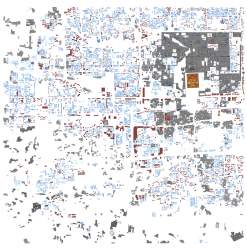
THE NEW URBAN FABRIC IS DENSE, YET COMMANDEERS AT ONE END WIDE TRACTS OF ARABLE LAND; AT THE OTHER EATS INTO THE HISTORIC HEART. STARCHITECT MEGAPROJECTS ARE CONCEIVED AND INSERTED AT DESIGNATED POINTS TO PROJECT THE IMAGE OF THE CAPITAL CITY OF A FUTURE SUPERPOWER. MULTILANE HIGHWAYS LACERATE THE CENTER. CUT-OFF TISSUE IN BETWEEN IS THROWN OUT IN CHUNKS TO THE MOST RAPACIOUS OF ACTORS WITHIN A STILL TEETHING REAL ESTATE MARKET. ALL ALONG THE URBAN FRINGE, WAVE AFTER WAVE OF RESIDENTIAL MEGABLOCKS, GIVE RISE TO ENTIRELY NEW SUB-CITIES. THE COMBINED PRODUCT IS AN EXPLODING BEIJING: ONE FRAGMENTING OUTWARDS WHILE DISINTEGRATING AT THE CORE.
THE CONCENTRATIONS OF URGES AND OUTBURSTS — GLITZ, SHANTY TOWNS, WALL STREETS, MODERN AMENITIES, NEON, LUXURY, STREET VENDORS, OLD STYLE MAOISTS ETC. — IS AS BEWILDERING AS THEIR FRACTURED SOCIO-SPATIAL INTER-RELATIONS. EXCLUSION IS EVERYWHERE AND OF EVERYTHING (PEOPLE, WEALTH, POLICY IMPLEMENTATION, RULE OF LAW), AND DIVISIONS APPEAR WITH THE SAME HARSHNESS AND IMMEDIACY AS ALTERATIONS TO THE STAGGERED SKYLINE.
CRITICISM BOTH FROM OFFICIALS AND CITIZENS FOCUSES ON SEVERE CONGESTION AND RISING REAL ESTATE PRICES. BUT WITH CHINA’S CONTINUING RECORD-BREAKING LEVELS OF INVESTMENT AND TOTAL LOVE FOR THE MOTOR CAR, THERE IS LITTLE TO SUGGEST ALLEVIATION ON EITHER FRONT. UNABASHED, LOCAL PLANNING DEPARTMENTS CONTINUE TO OK (READ PARTNER) EVER MORE STRATIFIED AND DISPARATE PROJECTS.
AT THE HEART OF BEIJING’S CURRENT CONTRADICTIONS AND SNAP RELOCATIONS IS THE FRAUGHT SHIFT FROM MONOCENTRIC RING CITY TO POLYCENTRIC MULTICITY. SHANGHAI HAS PURSUED A POWERFUL SATELLITE MODEL; THE PEARL RIVER DELTA AN OPEN MARKET REGIONAL NETWORK. BEIJING IS AT THE HEIGHT OF ITS AMBIGUITY AND BLUR. AS SUCH, IN THE MIDST OF PERIPHERAL BALLOONINGS, COARSE UPSCALING, CONGESTION TO THE POINT OF DYSFUNCTIONALITY, HAZE, AND BLATANT SPEED, IT IS THE ESSENTIAL CASE STUDY FOR DD.
BEIJING: PORTRAIT OF A CITY 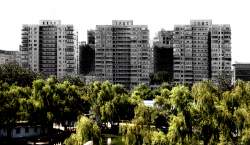
BEIJING IS MUCH BIGGER THAN YOU THINK, AND EXPANDING MUCH FASTER THAN OFFICIALS ADMIT. THE DEFAULT WESTERN VERDICT IS THAT IT SPRAWLS. BUT SPRAWL IS A TERM FREQUENTLY BANDIED, YET SELDOM SUBSTANTIATED WITH A DEFINITION. IT HAS BECOME A CATCH-ALL PEJORATIVE FOR UNWELCOME URBAN EXPANSION.
IN ONE SENSE THERE IS IN FACT NO SPRAWL IN THE CHINESE URBAN CONTEXT. BEIJING SITS AT ONE END OF THE LARGER ETROPOLITAN FIELD OF JING HU* — A CONTINUOUS (SEMI-)URBANIZED REGION WITH AN AVERAGE DENSITY OF 944P/KM2. THIS FIGURE IS OMPARABLE WITH A MEDIUM-SIZED AMERICAN CITY. ON THE LEVEL OF PURE DENSITY, JING HU* IS SPRAWL FREE.
HOWEVER, ANALYSIS OF BEIJING REVEALS A NUMBER OF NEW FORMS WITH DISTINCT QUALITIES, SOME OF WHICH IMPACT NEGATIVELY UPON THE URBAN DYNAMIC. PASSING FROM THE HISTORIC CENTER (THE BLACK HOLE) OUT THROUGH THE SURROUNDING URBAN CORE (THE PERICENTER) INTO THE RURBANIZING FRINGE (THE GREEN EDGE) AND THE WIDER FIELD OF GRAVITY, WE HAVE IDENTIFIED THESE FORMS AND EVALUATED THEM AGAINST THE ESSENTIAL CRITERION OF CITY ACCESSIBILITY. A –SPRAWL SUFFIX IS USED TO INDICATE RISK.
Sprawl has become a catch-all pejorative for unwelcome urban expansion. DCF sprawl derivatives describe and evaluate specific characteristics of that expansion which impact negatively upon accessibility.
‘摊大饼’已经成了一切不受欢迎的城市发展的总称. 我们这里所说的’摊大饼’指的是会影响到可达性的那些城市蔓延.
1. BEIJING: RING BY RING — A TYPOLOGICAL SECTION
BEIJING IS A CITY DOMINATED-DEFINED-DIVIDED-CONNNECTED- SERVICED- NAVIGATED-RATIONALIZED AND MOST COMMONLY DESCRIBED BY ITS RING ROADS.
THE CONCEPT FOR A RING AND RADIAL SYSTEM CAME INTO EXISTENCE IN THE 1950S, AND CLEARANCE WORK STARTED IN 1965. HOWEVER, THE CONTINUOUS BELT HIGHWAYS OF TODAY HAVE ALL BEEN COMPLETED DURING THE POST-REFORM ERA. PLANNING STRATEGIES PREDICTED THAT THE FOURTH RING ROAD WOULD SERVE AS THE EDGE OF THE CITY CENTER, THE FIFTH LINK SUBCENTERS,
AND THE SIXTH CONNECT SATELLITE TOWNS. REALITY QUICKLY OVERRAN THE SKETCHES. BY 2007 THE CITY CENTER SPILT WELL BEYOND THE FIFTH RING ROAD IN ALL DIRECTIONS.
BEIJINGERS TALK RINGS ABOUT THEIR CITY TO TELL EACH OTHER WHERE THEY ARE (”NEAR THE NORTH THIRD RING ROAD”, ”BETWEEN WEST THIRD AND FOURTH” ETC.). THE RINGS ALSO MAP THE TYPOLOGICAL AND POLITICAL HISTORY OF THE CITY.
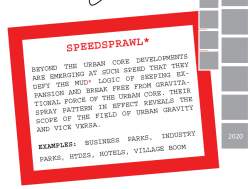
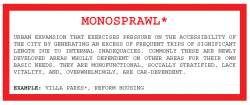
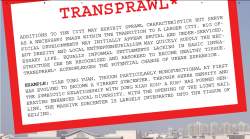
The First Ring Road
At the centre of historic Beijing lies the Forbidden City, itself encircled by the Imperial City (a collection of lakes and parks), in turn set within the old inner and outer city. A defensive city wall (now the Second Ring Road) once girt this basic structure of an annulus of citizen dwellings round the preserve of the emperor. The origins of Beijing’s ring-based transit system lie in the 1920s, when a 17km ring tram line was constructed to connect key points throughout the non-imperial wall-bound area. The disassembly of the tram lines in the 1950s reduced this once clearly defined route to a collection of road surfaces. Gradually these ceased to carry any special significance. Nowadays, the First Ring is little more than a question: ”What is it? Where did it go?”
Within the Second Ring Road
SECOND RING ROAD: 32km long; 1.4km2 surface area
Central Beijing is still dominated by hutongs*. A clear grid of major avenues demarcate cellular congregations of tight single story dwellings, themselves clustered around courtyards and along roads barely wide enough for a single car to pass. Historically this structure indicated celestial order; today it forces the bulk of traffic down a limited number of invariably busy intercellular arteries.
The cultural and indeed economic value of the hutongs* is a source of no little controversy. Inhabitations are mostly cramped and basic, with many homes relying on communal toilets for elementary sanitation. However, the hutongs* carry an undeniable social quality, and provide the essential context for the city’s historic sites and traditional identity. Bulldozing and redevelopment, dating from in the 1990s, has eaten away large patches of the old fabric. A new wave of interest, inspired in part by cultural heritage foundations, but also by monied foreigners seeking a more “Chinese” environment, has recently rehabilitated the value of the courtyard home. However, although large parts of the center are now officially protected from demolition, renovation-restoration-mod-con makeover projects are pursued without sensitive regulation, and rapid and often crude transformation of the historic environment continues.
Second to Third Ring Road
THIRD RING ROAD: 48km long; 2.9km2 surface area
The Maoist reconditioning of old Beijing maintained the cellular principle but redrew the cells, this time carving the city into separate units controlled by different danwei*. Each danwei* integrated home, work and leisure within the confines of the cell, thus negating the need for commutes. However the units themselves expanded, directed by their own individual needs and ambitions, and with little regard for overall city form. Development was frequently land-inefficient and uncoordinated. At the same time that the carinspired American consumer was driving out past the urban periphery to build a new suburbia, China too, under a productionist logic, was pushing beyond its city-boundaries. Ironically before cars or roads were introduced on any major scale, Beijing already found itself encircled by suburbs. A single housing typology was deployed: six story soviet-style walk-ups, all facing south.
Third to Fourth Ring Road
FOURTH RING ROAD: 65km long; 4.7km2 surface area
The reforms which started in 1978 marked a new era for Beijing — one of land values, investment in infrastructure, and real estate projects. Beijing’s already distended spatial configuration fueled big road thinking. The new highways of the 1980s, including the Second and Third Ring Roads, lashed Beijing with asphalt. The nascent development market responded with highway tower mass housing: slabs, crosses and hash shaped extrusions*, footed on large roads, reaching 25 stories, and wholly car-dependent. The dramatic upscaling of both building and street resulted in a new urban coarseness.
Fourth to Fifth Ring Roads
FIFTH RING ROAD: 98km long; 5.5km2 surface area
The sudden rise of Beijing’s super rich, in conjunction with the emergence of profit-driven development opportunities, rapidly led to a bevy of luxury residential compounds. These bear many of the same features as their predecessors (from danwei* blocks to highway towers) — cellularity, non-integration, homogeneity and essential monolithicism — and yet the pronouncement of these qualities in the young market context is that much harsher. The compounds’ walls and guards reinforce economic disparities with physical divides. The building process is one of seal and sear, by which a single block is fenced off, scorched of all previous qualities, and an international luxury imaginary is imported and materialized on site.
Lying at some distance from central Beijing, these exclusive gated communities, with their idiosyncratic reinterpretations of the Eurovilla or the Chinese watergarden (though never so traditional as to forget several generous carports), lay value claims to American suburban lifestyle, yet
further stress the already ailing transit arteries.
Fifth to Sixth Ring Road
SIXTH RING ROAD: 190km long; 13.8km2 surface area
Beijing’s relentless onslaught into itself — razing old neighborhoods to erect new build — throws both tissue and residents outwards. Mass redevelopment of the old city creates a reverse stream of former locals in need of new housing. Equally, new wealth and opportunities draw waves of migrants, and generate ad hoc program in cheaper locations. Beyond the Fifth Ring Road, among starkly delineated compounds and the slow concrete curves of elevated highways, mass creations of affordable housing unexpectedly arise. Monofunctional program quickly generates a bottom up response. Entrepreneurial zeal and obscure regulatory environments provide a fecund base for informal villages, which quickly emerge to service enormous underplanned developments, each housing thousands of people, and yet providing little else. As the perimeter of the city keeps creeping outwards, former villages are engulfed, and all along the rurbanized fringe buildings suddenly start gaining stories. Within the spreading mass, temporary pockets appear — worker enclaves specific to construction sites; brief floating villages* inside the restlessly shifting city.
Beyond the Sixth Ring Road
As Beijing’s formal expansions bleed into booming villages (themselves upscaling) and bustling factories (with significant worker populations compounded on site), the question arises as to where the city actually stops so as to define where it can be stopped. The influence of the capital is still apparent, with new roads being built and logistics networks developed. But at this remove the gravitational force exerted on the commuter by the center is weak.
Itentionally and unintentionally Beijing is moving away from the monycentric city model
无论是否有意识,北京正与单中心的城市模式渐行渐远规模的房地产项目则不断将小规模的自发性开发推向边缘地带.
BEIJING HAS LONG SOUGHT TO DECONGEST THE CENTER BY MOVING PEOPLE OUT. LAND REFORM HAS BEEN USED AS A TOOL TO FACILITATE THIS PROCESS. THE CHIEF PRODUCTS HAVE BEEN MASSIVE DEVELOPMENTS WHICH STRETCH THE PERIPHERY, AND THE LOSS OF DOWNTOWN IDENTITY.
--
MOVERS AND SHAKERS (FROM RENOVATION TO RELOCATION)
Unlike say New York or New Orleans, New Beijing is being built right where Old Beijing used to be. There was a city there already when they started, and as a result, the much-vaunted building boom of the last decades has equally been a demolition boom. Whole sections of the former city have disappeared. When the Urban Planning Museum unveiled an enormous 1:750 scale model of Beijing 2020, residents flocked less to see what was new than to find out if their homes had been swallowed up by the future.
One of the main factors facilitating the progression of bulldozers across much of the old city has been its own parlous state of maintenance. Older buildings prone to deterioration inevitably suffered during the years of political instability leading up to the Communist accession to power in 1949. Thereafter the establishment of public ownership disincentivized inhabitants from the practices of “good husbandry” (most commonly associated with proud homeowners). Governmental responsibility for the aging housing stock proved insufficient in a context where repairs, let alone modernization, were not only onerous and expensive, but equally lacked any clear reward. By 1990 50% of inner city houses were deemed dilapidated.
The House Transformation Program was initiated with a renovation objective in mind. A lack of funds and a lack of beneficiaries other than the actual residents (on the whole simple Beijing families with little political clout) made early progress slow. However in 1992 the Beijing government opened the trade of land use rights to profitable real estate venture, thus introducing market logic to a situation of poor homes on potentially valuable land. Private developers started to take an interest. . .. A small project in Debao neighborhood in 1993 involved the insertion of a number of commercial units into a Transformation Area. The sale of the new build recuperated the bulk of the renovation costs, thus firmly
establishing the developmental value of land locked up underneath old houses.
Traditional Beijing hukou* were forced into an increasingly precarious position: for one, their poor state of repair meant they were commonly regarded by local officials as backward, an eyesore, and costly to address; furthermore, they were occupying land oozing latent profit. The outlook worsened in 1994 when a major restructuring of the tax system funneled a greater proportion of tax revenue toward central government, and encouraged local governments to be more entrepreneurial in dealing with the shortfall. Suddenly finding themselves dangling, the sale of land use rights was an obvious place to turn. In the name of tackling the poor state of existing housing, commercial developers were invited in, essentially to remove the former families, level their homes, and start building more profitable program. To ensure a healthy governmental slice, a strong emphasis was placed upon office and commercial space; and in order to accelerate this process of wealth generation through House Transformation, extremely favorable conditions were created for the development of ransformation Areas (the total volume of which within the four inner city districts strikingly rose from 1,577ha in 1993 to 2,210ha in 1995). With the land coming in so fast and easy, and with the value of the new build shooting up, returns for developers were such that real estate quickly became one of the most attractive sectors in the continuously booming economy. Thus through a series of policy shifts, what initially looked like an expensive public works program became a major driver of economic growth, and a means toward the realization of urban capital. In essence, it became a producer of MUD*.
The backlash of this economic surge was that a policy whose origins lay in an objective to deal with poorer citizens’ leaky roofs and disintegrating windows was leased out as a tool to facilitate the cheap fast mass removal of thousands of downtown families. A couple of examples: under the green light of House Transformation, the Hong Kong real estate tycoon Li Kai Shing took on 10ha of downtown Beijing, just to the east of Tiananmen Square. In six months the area was evacuated, 1,800 families relocated, and the original houses wiped. In their
place now stands the Wangfujing Oriental Plaza: a steel and glass megacomplex of shopping malls, office buildings, five star hotels, and service apartments. In West Beijing, one sixth of the inner city was emptied out — including 14,000 families — again in the name of House Transformation, in order to develop an area which would shortly be renamed Financial Street. Still under construction in 2007, Financial Street has explicit aspirations to become Wall Street China. With its towering skyscrapers and tackling cranes, it is a paragon of New Beijing.
In the years 1991–2003 it is estimated that 500,000 Beijing families were relocated. Occasional “nail families” refuse to go, and mesmeric photos still turn up in the Western press of a single house engulfed by a vast construction site. But for the most part, people take the ompensation, and move further out to new cheap mass housing. For the moved, living conditions generally are more advanced on a simple developmental scale, though undeniably something else is lost.
More roads, more traffic... Beijing is caught up in a self-fulfilling prophecy
路更多,车也更多,北京陷入了自我应验的预言的怪圈
3. BEIJING: CAR
BEIJING HAS PURSUED A POLICY OF MASSIVE HIGHWAYS IN THE MIDDLE OF THE CITY. THE CHIEF PRODUCTS HAVE BEEN CONGESTION AND COARSENESS.
--
JAM
Building a massive road system in Beijing — even at a time when car ownership was rare – proved to be a self-fulfilling prophecy. The summary evictions and constructions of the ring road building in the 1980s were the prelude to the flash motorization that started in the mid ’90s. People were seduced into cars, but equally they were pushed. Extreme disruptions to the city fabric made by the new super-roads rendered alternatives increasingly impossible. Distances got bigger, and the urban environment markedly less friendly to bicycles, or pedestrians trying to cross a road to get to a bus or subway stop. Add to this the allure factor — the status attributed to car owners in China — and the result has been unequivocal: Beijing’s vehicle fleet doubled from 1 to 2 million in the years 1997 to 2003, topped 3 million in 2006, and
is expected to exceed 5 million well before 2020.
Road building however has not been able to keep pace. In spite of massive efforts, including a doubling of paved surface area in the post-reform period up to 1999, maintaining former car to road space ratios is simply not feasible. Nor is it desirable.
Inner city rings have consumed vast areas of downtown space, created stark divides between neighborhoods, and impacted severely upon air quality, not least in dense residential areas. Exhaust fumes account for over 50% of Beijing’s pollution, making it the world’s most polluted capital, with distinct corridors of dirty air hanging over the major routes. Respiratory issues are pandemic across the city, with lung cancer being the number one cause of death.
Costs to the city arising from congestion are equally alarming. Average vehicle speeds on the main streets of Beijing dropped to 12kmh in 2003, with lows of 7kmh, effectively throwing drivers back to biking speeds. Traffic affects the central ring roads for 13 out of 24 hours. This not only presents substantial direct losses in terms of fuel and man hours, but also degrades city accessibility. Places are often simply too arduous to get to. Professional and recreational decisions are restricted accordingly, leading to significant business losses.
From any position Beijing casts a pattern of blind spots – places too inaccessible to treat as regular destinations. One has to conclude in daily life most of the city is out of reach.
不管你在北京的哪里,城市都是有盲点的 - 总有一些地方不能轻而易举地到达.我们不能不承认,对于居民的日常生活来说,北京的大部分地方都是够不着的.
A key contributor to Beijing’s poor performance in terms of traffic is the city layout, which both historically and currently displays a tendency toward cellular structures, with marked schisms between large intercellular roads and small intracellular roads. hutongs*, communist dormitory compounds, blocks of dormitory extrusions*, gated communities, and the big office towers of the CBD and elsewhere all internalize large areas of road surface which are either closed off or unamenable to through traffic. Consequently, vehicles are all driven down a limited number of larger, more arterial roads. These tend to be two-way and multi-lane, with regular traffic knots at left turns and around compound exits and entrances. Crucially, these points of first contact with urban public space are gruesomely inhospitable. Most contemporary developments are either car orientated by design, or simply lack a competitive public transport option. Developers continue to break new ground in the suburbs without reference to a larger urban plan, and infrastructure is constantly playing catch up.
“The contradiction between real estate development and traffic regulations is the biggest problem now facing Beijing,”
— Wang Qishan, Mayor of Beijing (2004)
4. BEIJING: SOCIAL
INTRODUCTION OF MARKET REFORMS HAS FOCUSED ON URBAN DEVELOPMENT AS A MAJOR DRIVER OF ECONOMIC GROWTH. THE CHIEF PRODUCT HAS BEEN CRUDELY STRATIFIED CITY ISLANDS WHICH FAIL TO INTER-RELATE.
--
EXPANSION AND EXCLUSION
The uncompromising overwriting of dense areas of Beijing in order to instate the ring road system has had radical consequences for the urban texture. Flyovers and clover leafs drew apparently arbitrary lines across old neighborhoods, introducing sudden divisions, cutting off odd quadrangles, and isolating the pedestrian within unnavigable skeins of road. To connect the different patches, thousands of footbridges have been erected, and tunnels dug.
At the same time, individual building projects have ballooned in size, disbanding the notion of local neighborhoods. Social interaction and commercial services have been displaced outside the residential realm in pursuit of large-scale compounds for the new middle class. The concept of suburbia is offered at high-rise density and executed with blatant copy-paste efficiency. Large wall-like congregations of towers encircle a small communal space on top of a parking garage. These are the new building blocks of Beijing’s remarkably coarse urbanism. In the cases of Tian Tong Yuan and Wang Jing, single step developments accommodate populations approaching 500,000 people*.
Operating on such a scale, typological decisions rapidly define the masterplanning of an area. The new residential compounds act as single stamps, and yet their size makes them urban elements. They are inserted with minimum regard for circulatory ramifications or urban facilities, forming suburban bubbles within the downtown, and stark high-rise at the fringe. The sum of these Chinese stamps, loosely jostled among highways and leftover space, comes to define the city, reducing urban design to the practice of bloated architecture*.
The tendency of the stamps to be directed at single income brackets has also led to increasing social segregation. Expanding economic divisions within contemporary Chinese society find expression in fortified real estate projects, and while the introduction of a housing market has been a major growth driver toward the xiao kang* society, with it have come jagged housing inequalities. These are all the more striking when it is considered that communist standards of accommodation parity (at least among workers within individual danwei*, if not across the city or across the urban / rural divide) are for many within living memory.
For some old Beijingers housed within the more powerful danwei*, post-reform welfare structures have encouraged the purchase of their previously stateowned apartments. However for those drawn to the city by new opportunities and without the appropriate hukou*, the market is much less affordable. In addition to large scale estates for low to medium income inhabitants (such as Tian Tong Yuan and Wanjing), and the upmarket gated “plazas” of flashier towers or villas (and the top end of Beijing real estate has entered the global elite of super-exclusivity), at the bottom end, illegal and uncoordinated development is profuse. Migrant worker housing may be attached directly to specific construction sites. Equally it may develop informally in response to an official urban expansion project (as with Dong Xiao Kou*), or operate as a illegal suburb bubble in its own right (as with Zhejiangcun*).
Often these different faces of stratified Beijing are spatially dislocated. Sometimes they are wedged cheek by jowl in crammed sub-centers, leading to bewildering juxtapositions of dilapidation, wealth density, and communist history. Within such contexts, new expensive multi-story compounds dissever themselves from the nearby lower buildings by height and access ways, leading to a 3-D stratification effect*. The various strata correlate directly to a particular relationship with public space, whereby basement shanty-towners rely on their feet, commieblock residents traipse to the subway and back, and inhabitants of gated communities are permanently shielded from the urban realm by the windscreens of their cars.
For the time being Beijing’s famously over-heated real estate market shows little sign of cooling. With apartment prices continuing to rise at 20–30% per year (well in excess of stagnant wage growth), the haves are not only maintaining their distance from the have-nots — they are in fact pulling ever further away. This accelerating economic disaggregation is another, this time socio-economic, aspect of exploding Beijing.
THE OFFICIAL RESPONSE
AT THE HEART OF ALL PLANNING STRATEGIES HAVE BEEN TWO GOALS: ENCOURAGE GROWTH — CURB CONGESTION. THESE CONTINUE TO DOMINATE CURRENT PROPOSALS, EVEN THOUGH METHODS HAVE CONSISTENTLY PROVED TO BE AT ODDS WITH RESULTS.
--
BEIJING 2020 — MASTERPLAN
In 2004, the Beijing Municipal Commission of Urban Planning produced the revision to the 1993 Beijing Master Plan for the year 2020. The objective was to create new guidelines to accommodate the city’s unprecedented expansion and tackle inefficiencies that had accumulated since the introduction of market reforms. Confronted by a city that seemed to be growing recklessly and even randomly, the first comprehensive plan for Beijing — including elements aimed to respond to market (and market-like) urbanizing forces — was formulated. The result was the “Beijing Spatial Development Strategy”. Further tweaking has yielded the contemporary planning proposals, which are focused
on three key points.
1. High intensity development is to be promoted eastwards toward the metropolis of Tianjin, and, as an environmental counterbalance, low intensity development is to progress westwards toward the mountains. This forms the structure for the “Two Axes Two Corridors — Multicenters” plan. By this, Beijing aims to retain its traditional north-south and east-west axes, and gain two corridors on either side of the center (running north-east to south-east, and north-west to south-west), which focus development, connect up and strengthen outlying polycenters, and thus relieve congestion in the downtown area. The Eastern Development Corridor is to be a dense straight of highly urbanized land incorporating both residential and business program along an arc of new satellite cities. The Western Development Corridor is to remain low density, with a focus on high-tech, eco-industry, culture, entertainment and leisure.
2. Designated cultural, historic, and environmental sites and open spaces are to be protected from (further) urban development.
3. The principle of “develop transportation infrastructure first” is to guide planning, and land development is to be confined within the capacity of
the transportation system. Development of transportation infrastructure is focused on three modes:
i. A massively upgraded road network, encompassing country roads, village streets, linkage routes, and expressways. The explicit aim is to bring node to center trips down to a one hour drive. Expressways are to be built connecting every suburban district and country center to the central downtown area, and linkage routes are to run from subordinate towns to country centers. ii. An extensive subway and light rail network. 20 lines comprising 561km of track are to be up and running by 2015 (from 4 lines of 142km in 2007). iii. An improved and diversified bus service. The wide reaching “Bus Service for Every Village Project” is to be continued, ensuring comprehensive bus services for all urban and rural residents of the Beijing area. Within the city proper, the Bus Rapid Transit System (BRT) will serve to reduce traffic by addressing the positioning of congestive bus stops. The BRT will be assisted by a centralized intelligent taxi data system, which will serve to minimize the number of empty cab journeys.
REALITY CHECK
CONTEMPORARY APPROACHES CONTINUE TO EXPRESS THE SAME ESSENTIAL CONTRADICTIONS: DECONGEST THE CENTER BY ENFORCING LONGER TRIPS; STAUNCH MOTORIZATION BY FEEDING IT MORE ROADS. THE PLANS MOVE OUT PEOPLE WHO DON’T HAVE CARS, BUILD BIGGER BLOCKS AT BIGGER DISTANCES, AND EXPECT PUBLIC TRANSPORT TO SOLVE COMMUTING. THIS WILL NOT PROVE EFFECTIVE. THE ILLUSIONS DRAWN UP WILL HIT A HARD REALITY IN THE FORM OF INACCESSIBILITY: THE ESSENTIAL PHENOMENON WHICH CHARACTERIZES MODERN BEIJING.
--
WHILE BEIJING IS ADVERTISING ONE FUTURE, CURRENT REALITIES ARE STRAINING IN ANOTHER DIRECTION. THE HISTORY OF BEIJING PLANNING / REALITY MISMATCHES IS ONE OF ACTUAL GROWTH CONSISTENTLY OUTPACING NOT ONLY PLANS, BUT THE RATE AT WHICH
THOSE PLANS ARE BEING DRAWN. PROJECTIONS ARE OUTDATED ON RELEASE AND LOOK LIKE OLD MAPS. PLANNING IS REDUCED TO POSTPLANNING: A MIXURE OF WISTFUL THOUGHTS AND POLITICAL PROPAGANDA.
DISPARITIES BETWEEN BEIJING AS A SUBJECT FOR URBAN DESIGN AND BEIJING AS A RAPIDLY EXPANDING MEGACITY ARE EXACERBATED BY THE PRIORITIZING OF ECONOMIC GROWTH (OFTEN REAL ESTATE DRIVEN) OVER DESIGN OBJECTIVES; THE INFORMALITY AND OBSCURITY SURROUNDING EACH AND EVERY INDIVIDUAL DEAL BETWEEN PRIVATE DEVELOPERS AND LOCAL OFFICIALS; AND THE
LARGE, EXTREMELY ACTIVE, AND CONSISTENTLY IGNORED INFORMAL POPULATION. THUS THE CHIEF AGENTS OF SPATIAL PRODUCTION
ARE DISENGAGED FROM CITY-WIDE PLANNING PROCESSES, WHILE PLANNERS THEMSELVES REFUTE THE MUD* PROCESSES BY WHICH DEVELOPMENT IS ACTUALLY OCCURRING.
AS MUD* CONTINUES TO ADD MATTER TO THE REAL BEIJING, A FAKE BEIJING IS EQUALLY UNDER PRODUCTION. FAKE BEIJING 2008 IS A GLOBALLY MARKETED CITY. IT CONSISTS OF A LIMITED NUMBER OF STARCHITECT BUILDINGS (“BEIJING IS MODERN”), UNESCO WORLD HERITAGE SITES (“HISTORICAL SEAT OF IMPERIAL POWER”), AND THE VERDURE WALLING OF INFRASTRUCTURE (”GREEN CITY, SUSTAINABLE CITY”). IT IS LENT FURTHER SUPPORT BY VIRTUAL BEIJING 2020 — A CITY WHICH EXISTS ENTIRELY ON HARD DRIVES, AND IS VISITED VIA CGI FLYTHROUGHS OF IMPECCABLY METROPOLITAN DISTRICTS (GLASS WRAPS, STEEL DIAGONALS, ELECTRONIC MUSIC ETC.). FAKE BEIJING BRANDS ITSELF FOR FOREIGN INVESTORS, FOR TOURISTS, AND FOR ITS OWN POPULATION — PLACATING UNREST WITH THE PROMISE OF AN ENTIRELY NEW CITY — A NEW FUTURE — LYING JUST BEYOND TOMORROW.
BUT FAKE BEIJING IS ENGAGED IN A CONSTANT AND EXPENSIVE PROCESS OF SAVING FACE. IT DEMANDS ENORMOUS CASH INJECTIONS
FOR ITS HUBRISTIC MEGAPROJECTS (THE OLYMPIC STADIA, CCTV, THE NATIONAL GRAND THEATER ETC.). SHABBY AREAS ARE PUSHED OUTWARDS. ENORMOUS VOLUMES OF WATER ARE DRAWN IN FROM OUTLYING CATCHMENT AREAS AND DISTANT DIVERTED RIVERS
TO MAINTAIN THE THEATRE SCREEN OF LUSHNESS. 30 YEAR OLD TREES ARE TRUCKED IN, STOOD UPRIGHT, AND CONNECTED UP TO
AN AUTOMATIC HOSE ...
CLEARLY THIS IS NOT A MODEL OF SUSTAINABILITY. TISSUE BETWEEN THE GLOBAL MEGAPROJECTS IS BECOMING COARSER AND
HARSHER, AND THE WATER TABLE (NOW 90% CONTAMINATED) IS AT AN ALL TIME LOW. FAKE BEIJING PREENS ITSELF IN THE MIRROR
AND WAITS FOR THE OLYMPICS. ALL THE WHILE, REAL BEJING IS SUBJECTED TO SPLINTERING FORCES.
====//Top-down megaprojects periodically push small informal ....
Owned by neville mars / Added by Stephanie Yao / 17.8 years ago / 324005 hits / 38 hours view time
Backlinks
Tags
Latest Entries
Contribute
Login to post an entry to this node.
